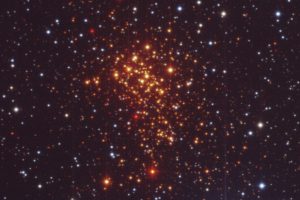The program “Testing protoplanetary disk evolution and brown dwarf formation in starburst: NIRCAM and MIRI observations of the young cluster Westerlund 1” of M. G. Guarcello (INAF – OAPA) is among the accepted proposals of the JWST Cycle 1

The James Webb Telescope (JWST) will be the most complex and powerful telescope ever launched into space. Built by a consortium formed by NASA, ESA, and the Canadian Space Agency (CSA), thanks to its primary mirror with a diameter of 6.5 meters (for comparison, the mirror of the Hubble Space Telescope has a diameter of 2.5 meters) and its four instruments, JWST will operate in a wide infrared band, from 0.6 to 30 μm, with a unprecedented angular resolution (0.07 arcsec at 2 μm).
JWST will revolutionize our knowledge on several fields in astronomy, such as cosmology, formation of the first galaxies, star formation, and exoplanetary science. Despite the telescope has not been launched yet, on November 2020 all the astronomers interested in doing science with JWST were called to submit their proposals and projects to a panel of about 200 experts. The large numbers of proposals for observations submitted by the international community demonstrated the wide interest in JWST.
Among the 286 accepted proposals, there is the program: “Testing protoplanetary disk evolution and brown dwarf formation in starburst: NIRCAM and MIRI observations of the young cluster Westerlund 1“, led by the astronomer Mario Giuseppe Guarcello of INAF – Astronomical Observatory of Palermo. The project consists in 19.7 hours of observation with the instruments NIRCAM and MIRI of the starburst cluster Westerlund 1, as part of the international project EWOCS (Extended Westerlund One Chandra Survey) led by M. G. Guarcello. The project has two main objectives. The most important is to identify all the stars in Westerlund 1 still hosting a protoplanetary disk, e.g. the disk structures orbiting around young stars from which planetary systems may form. In the starburst environment of Westerlund 1, in fact, the intense UV radiation field produced by the rich massive population of the cluster and the gravitational interaction between the stars of the cluster can accelerate the dispersal of disks, which may occur in times shorter than those required for planets to form. The second objective is to study the population of very low mass stars (brown dwarfs) of the cluster. The intense local UV field, in fact, may have affected the spectrum in mass of the stars formed in the cluster, resulting in an anomalous production of very low mass stars. Since Westerlund 1 is the prototype of a type of clusters which is rare in the Milky Way today, but it is quite common in the Early Universe and in the interacting and active galaxies, this project will allow us better understanding how star and planets formation occurred in the early evolution of galaxies.
The image (click here to visualize the entire figure) shows a Westerlund 1 image acquired with the 2.2-m MPG/ESO Wide-Field Imager telescope of the European Southern Observatory. JWST observations will resolve and detect more stars in the cluster core, allowing us to obtain a rich census of stars with disks and low-mass stars in the cluster.
